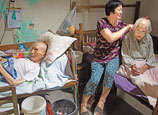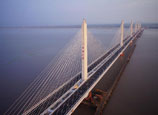
HENGYANG, Hunan, July 7 (Xinhua) -- Although he is in his 90s, Tan Rongsheng remains strong and robust. He likes to outfit himself in military-green clothing, so he'll never forget his days as a soldier in the China Expeditionary Army.
At 16, Tan joined the newly-established China Expeditionary Army and participated in the War of Resistance Against Japanese Aggression (1937-1945) in Burma, now Myanmar, in 1942.
He and his comrades-in-arms saved more than 7,000 English soldiers, American clergy members and journalists in the famous Battle of Yenangyaung, a battle that took the lives of over 200 soldiers.
Seventy-one years later, he finally saw a memorial tablet dedicated to those soldiers who died in battle sent from Myanmar to their hometown, Hengyang City, central China's Hunan Province, on Sunday.
Sunday was also the 76th anniversary of the Lugou Bridge Incident, which marked the beginning of the nationwide War of Resistance by the Chinese People Against Japanese Aggression in 1937.
Inscribed with a dedication to "the 202 officers and soldiers who died in the Battle of Yenangyaung," Tan and other volunteers escorted the 1.5-meter-high and 40-kilogram wooden tablet into Nanyue Memorial Hall, which is also used to commemorate officers and soldiers of the Kuomintang (KMT) during the war.
"Most people who attended the war in Burma were natives of Hunan. Placing the tablet in the memorial hall in Hunan means to revert the souls of the deceased to their origin, just like fallen leaves should return to the roots," said Liu Weimin, son of Liu Fangwu, a regiment commander of the army.
For various historical reasons, the remains of the soldiers who died in the battle could not be properly settled or worshipped, Liu said.
"Only after waiting there for 71 years, can they return to China, their country, and back to Hengyang, their hometown, where their relatives and friends live," Liu said.
"In recent years, amid the development of the Chinese economy and a deepening understanding of history, an increasing number of volunteers and descendants of those soldiers have paid more attention to this issue. They repaired graves and reconstructed memorial tablets for those departed soldiers," Liu added.
According to incomplete statistics from a website devoted to promoting the history of, and raising awareness about, the China Expeditionary Army, 500 to 600 soldiers from the army are still living in the country, but all are very old.
"As people have become more concerned about the history of that time, the old soldiers get more concern and help from society," said Shu Hongjian, the website's managing editor.
The Ministry of Civil Affairs recently said governments at all levels should help and raise awareness about elderly former servicepeople, including former KMT soldiers.
According to statistics from the civil affairs department of Hunan, the province is home to more than 500 former KMT soldiers, as it was a major battlefield during the War of Resistance Against Japanese Aggression during World War II.
Meanwhile, an assistance program for veterans was launched on Friday, offering every confirmed veteran 10,000 yuan (1,630 U.S. dollars) annually.
"However, there are still a lot of surviving soldiers in need of care and help. It is the conscience of society and also the responsibility of history to take care of them, as their sacrifices and bravery defended the dignity of the Chinese people, as well as the territorial integrity of the country," said Zheng Jianbang, vice chairman of the Revolutionary Committee of the Chinese Kuomintang (RCCK) Central Committee.
















 First panda born in Taiwan is female | Photos
First panda born in Taiwan is female | Photos


![]()
